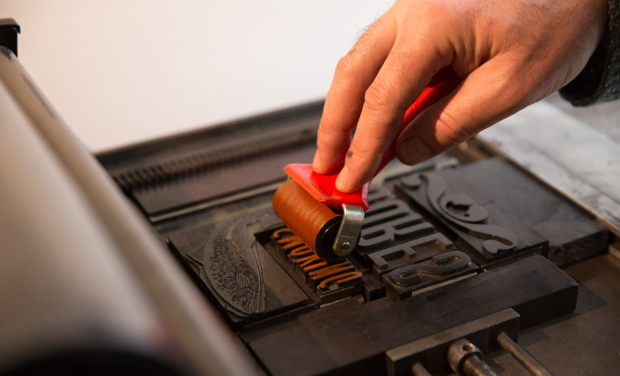Leytonstone man leads letterpress revival
Slowly but surely, technology is becoming effortless. A toddler can use a computer these days, and as a species we’re used to all manner of machines which would have baffled our forbears.
But for Russell Frost learning about technology works both ways. His hobby, which has evolved into a passion, is letterpress printing, which from its invention by Johannes Gutenberg in the 1450s until the mid-twentieth century, was the primary method used for all things printed, including the Bible and the Complete Works of Shakespeare.
Frost is part of a letterpress revival, a craftsman who sees value in this old technology and who wants to exploit its artistic potential. His workshop in Leytonstone contains several well-travelled presses, each with their own individual mechanisms.
“I don’t live in the past,” he assures, “but I love aspects of the handmade and the way they did things.”
Frost grew up in a remote, mountainous part of New Zealand and trained as a landscape architect before becoming a “professional fly fishing guy” for six years. Now 40, he lives in Leytonstone with his wife and daughter and is trying to make a go of it selling his prints.
“Someone gave me a business card that had been letterpress printed which sort of got me thinking,” he says, explaining how he started out. “As a fly fishing guy I had my own little company and wanted to print my own vouchers so I made my own block, carving it gung ho with a dentist’s drill.”
Frost shows me a Vandercook proofing press, the gold-standard for artisan letterpress work. The ‘form’, blocks of type locked together into what you want to print, goes on the bed of the press. Then you apply ink using a roller before passing paper over it on a rotating cylinder. My effort smudges, but the visual definition and crispness is far superior to what I get from my Laser Jet at home.
Frost’s prints lend themselves to word play and visual gags. One of his latest editions shows a leaping salmon with the text: “Smoking cures.” The pun is a satirical nod to vintage advertisements and true in a culinary sense. Another print bears the slogan “Give me hops” in a homage to craft brewing. There’s often some historical association, or reason for using a particular font: when we first met, at an exhibition next to Leytonstone station organised by Transport for London, he was allowing members of the public to make a print using the original London Underground font.
It’s surprising how readily printers abandoned the letterpress, which had served us well for so long, once offset and digital printing came along in the twentieth century. Old presses were dumped in woods, sold for scrap metal or burnt on bonfires outside print works. Beautiful sets of type in Frost’s collection are badly charred, and one press he bought in Wellington he discovered had been used for toasting marshmallows at Christmas.
But letterpress printing lives on, not only through people like Frost, but in the very words we speak. A ‘chase’ is a steel frame that the type goes inside before being printed. From it is derived the expression ‘cut to the chase’. A piece of type is called a ‘sort’, from which we get the term ‘out of sorts’. It makes you wonder how many technological expressions we use today will be in circulation long after that technology has moved on.
Russell Frost is resident artist this month at The Hawkhurst Vault 240 Brick Lane, E2 7EB.

